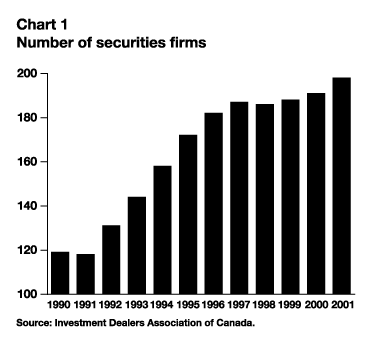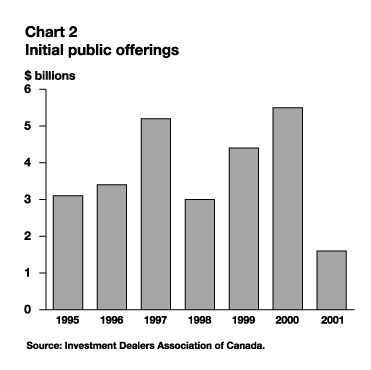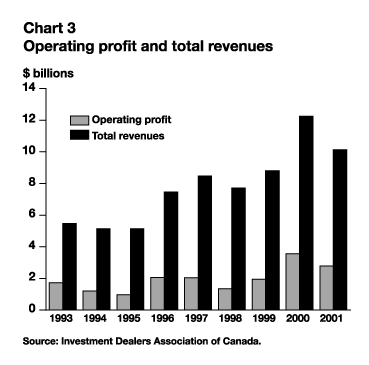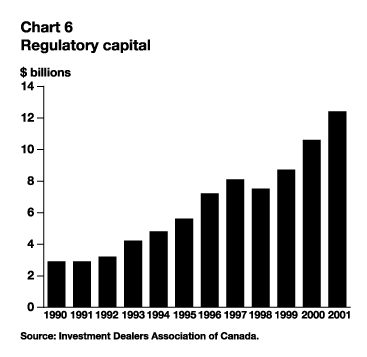|
|
- All Financial Sector Fact Sheets -
Canada’s Financial Services Sector
Canada’s Securities Industry
July 2002
Overview
- The Canadian securities industry plays a key role in Canada’s financial system. It raises debt and equity capital for businesses and governments and allows investors to trade with confidence in open and fair capital markets.
- Canada’s securities industry grew significantly during the 1990s, and by the end of 2001 included 198 firms providing employment to just over 37,000 people across Canada.
- The industry is made up of integrated, institutional and retail firms. In 2001 the seven largest integrated firms, which include the securities dealer affiliates of the six major domestic banks and one major U.S. dealer, generated over 70 per cent of the industry’s revenues.
- The securities industry, while not reaching the record highs posted in 2000, had a solid performance in 2001, with revenues totalling $10.1 billion and operating profits $2.8 billion. Net income was slightly lower than in 2000 but still exceeded $1 billion, largely due to a strong fourth-quarter performance.
- Return on equity averaged 18 per cent in 2001, down 3 percentage points from the previous year and slightly lower than the average rate of return over the past 10 years.
- Canada’s major exchanges reached an agreement in 1999 to realign their responsibilities: the Toronto Stock Exchange (TSE) became the sole senior equity exchange, the Montreal Exchange assumed responsibility for all derivatives such as stock index options, bond futures and stock options, and the Canadian Venture Exchange (CDNX), created through a merger of the Vancouver and Alberta (and later Winnipeg) exchanges, took over sole responsibility for junior equity.
- In May 2001, the TSE signed an agreement to acquire full ownership of the CDNX, thus bringing all of Canada’s equity trading under one organization for the first time. In April 2002 the CDNX was renamed TSX Venture Exchange, and is now part of the TSX Group, which also includes the Toronto Stock Exchange (TSX) and TSX Markets.
- Following the conclusion of an agreement with the Quebec government, the first phase of Nasdaq Canada was launched in November 2000, with the placement of Nasdaq Stock Market U.S. terminals in Montréal and the launch of the Nasdaq Canada brand.
- The industry is regulated at the provincial and territorial level. In addition, self-regulatory organizations such as the exchanges and the Investment Dealers Association of Canada also play an important regulatory role.
Introduction
Canada’s securities industry dates back to 1832, when shares of Canada’s first railroad were traded by a small group of brokers in a Montréal coffee house. Canada’s first stock exchange, the Montreal Stock Exchange, was incorporated in 1874, followed by the Toronto Stock Exchange, which was incorporated under a special act of the Province of Ontario in 1878. The chartered banks became the first and leading underwriters of Canadian securities, maintaining their lead in that field for many years. However, by the turn of the 20th century, their earlier dominance in underwriting had to some extent been diminished due to the increasing number of brokers specializing in the bond business, as well as the concentration of underwriting business in a small number of firms. By 1927 about 60 per cent of securities issued were underwritten by five investment dealers and one bank, with the five dealers accounting for 47 per cent of the total.
Until the late l980s most of the independent securities firms were owned by their senior partners, a structure that became increasingly difficult to maintain due to increasing demands on capital, growing competition from global players, greater market volatility and cyclical earnings performance. In response, in the mid-1980s, the federal and provincial governments introduced legislative changes to open up ownership of the securities industry to Canadian banks and trust companies, as well as foreign securities firms.
The result was a major ownership realignment of the securities industry. In order to enter the retail brokerage sector and to strengthen their activities in investment banking, five of the big six banks acquired major investment dealers while the sixth built its own brokerage business from the ground up. By the end of 2001, when the Canadian Imperial Bank of Commerce finalized its acquisition of Merrill Lynch’s Canadian retail brokerage business, all of Canada’s large, integrated securities firms were bank-owned (see Table 1). The major banks typically carry out some securities activities, such as wealth management and discount brokerage activities, through one or more other business units, in addition to the securities firms themselves. In addition to the large integrated firms, there are smaller integrated firms, which also offer both retail and institutional business to clients.
Table 1
Bank ownership of integrated securities firms
|
|
|
| Firm | Majority owner |
|---|---|
|
|
|
| BMO Nesbitt Burns | Bank of Montreal |
| CIBC World Markets | Canadian Imperial Bank of Commerce |
| National Bank Financial | National Bank of Canada |
| RBC Dominion Securities | Royal Bank of Canada |
| Scotia Capital | The Bank of Nova Scotia |
| TD Securities | TD Bank Financial Group |
|
|
|
Structure of the Canadian securities industry
The securities industry is made up of integrated, institutional and retail firms. Integrated firms offer products and services that cover all aspects of the industry, including both the institutional and retail markets. Institutional firms provide services exclusively to pension funds, insurance companies, mutual fund organizations, banks and trust companies, while retail firms, which include full-service firms and discount brokers, offer a wide range of products and services for retail investors.
The number of firms participating in the Canadian securities industry has risen significantly since 1990 (see Chart 1). At the end of 2001 there were 198 securities firms operating in Canada. The seven largest integrated securities firms, which include those owned by the six major domestic banks and one major U.S. dealer, accounted for 71 per cent of total industry revenues. Retail firms accounted for 20 per cent of revenues while foreign and domestic institutional firms accounted for 9 per cent.

Employment in the securities industry, which had grown steadily since 1992, fell by 6 per cent in 2001 to just over 37,000. This decrease, the first after almost a decade of steady growth, may be the result of the marked slowdown in trading activity and new equity issuance in 2001. Employment growth in the past few years has largely been driven by strength in the retail sector of the industry, reflecting the increasing number of Canadians investing in the equity market as well as an aging population concerned with saving sufficient funds for retirement.
The Canadian securities industry plays a key role in assisting corporations and governments to raise capital. In 2001 approximately $16.5 billion in new equity was raised for start-ups and existing businesses, down 29 per cent from the previous year, and $40 billion was raised in the corporate debt market, down 7 per cent. In addition, new issues of government debt for all levels of government totalled almost $69.5 billion during 2001, down 6 per cent from the previous year. The significant decline in new equity and corporate debt issuance was largely due to the slowdown of the domestic economy and the continued fallout of the technology sector throughout the year. The decline in new government issues is entirely attributable to a decline in new issues of provincial government debt.
In 2001 initial public offerings (IPOs) totalled $1.57 billion, the lowest total recorded in recent history and down considerably from the record high of $5.4 billion in 2000 (see Chart 2). The average size of IPOs increased significantly in recent years, especially between 1998 and 2000, when it nearly doubled to $24 million. This was largely due to the issue of non-traditional IPOs such as the demutualization of Canadian life insurance companies. However, the average size of IPOs issued in 2001 decreased to $12.8 million.

Profitability and revenue
The economic slowdown and the acts of terrorism in the U.S. on September 11 represented serious challenges for the securities industry in 2001, which saw its total revenues decline by 17 per cent from a year earlier. Nevertheless, total industry revenues reached just over $10 billion. Annual operating profits, while down from the record $3.6 billion posted in 2000, totalled $2.8 billion, the second highest result on record (see Chart 3). Net income was slightly lower than in 2000 but still exceeded $1 billion, largely due to a strong fourth-quarter performance. The exceptional profit levels reached in 2000 were largely due to strength in the retail sector, particularly in the discount/online businesses, which benefited from the rise in the high-tech market.

However, in 2001 small independent retail firms and discount brokerages, which opened up the securities markets to clients previously focused on guaranteed income certificates and mutual funds, experienced sharp declines in revenues and profits due to weak business activity. Integrated firms recorded a smaller decline in revenues than other sectors of the industry, posting profits of $2.3 billion, or 83 per cent of the industry’s total profits. This was largely due to the strong performance of fixed-income trading as investors’ interest shifted from equities to debt. In 2001 fixed-income revenues increased by 58 per cent over the previous year, reaching a record high of over $1 billion. Revenues from equity trading, after reaching a record high in 2000, fell by two-thirds to $384 million (see Chart 4). This decline in revenues was largely due to the deterioration in the stock markets, and was further accentuated by the tragic events of September 11, 2001. However, revenues for the last quarter of the year rebounded to their highest level since the last quarter of 2000.

Securities firms have also been instrumental in raising debt in capital markets for all levels of government to help fund their operations. However, improvements in federal and provincial government finances have reduced the amount of bonds issued in the government debt market, as well as the amount of debt that is rolled over. Also, activity in the domestic money market declined over the past five years, as trading in government Treasury bills decreased sharply due to the continued improvement of the federal government’s financial position.
Industry revenue is made up of commission revenues (including mutual fund transactions), investment banking revenues (underwriting fees and mergers and acquisitions), fixed-income and equity trading revenues, net interest revenues and other revenues (see Chart 5). As mentioned above, fixed-income trading revenues exhibited exceptional growth in 2001 as investor interest gravitated away from equities to debt due to the deterioration in the stock markets. Apart from investment banking revenues, which grew modestly, all other categories of revenue registered a decrease in 2001.

Commission revenues, which account for close to half of the industry’s revenues, amounted to just over $4 billion, down 29 per cent from the previous year, reflecting weaker fund sales and general lack of investor interest. However, commission revenues in 2001 were still at their third highest level on record.
Revenues from investment banking, which accounted for 21 per cent of total revenues in 2001, climbed to over $2.1 billion, an increase of just $10 million over the previous year. Equity trading revenues, which in 2000 exceeded $1 billion due to greater merger and acquisition activity and new equity issuance, dropped by 66 per cent in 2001 - the largest decrease among all revenue categories.
The average return on equity of the Canadian securities industry was 18 per cent in 2001, down 3 percentage points from the previous year and slightly lower than the 20-per-cent average rate of return over the past 10 years.
Structure of Canadian capital markets
The two main products traded in the securities industry are fixed-income securities and equities. Fixed-income products, which include bonds, asset-backed securities and money market instruments, are traded in dealer markets.[1] Equity products, which include common and preferred shares, are mostly traded on stock exchanges.
In 1999 Canada’s established exchanges underwent a major realignment in order to operate along lines of market specialization and to better compete with exchanges abroad and new electronic entrants penetrating the Canadian market. The Toronto Stock Exchange (TSE) became the sole senior equities exchange, the Montreal Exchange (ME) became the derivatives exchange (options and futures contracts), and the former Alberta and Vancouver exchanges became the Canadian Venture Exchange (CDNX), assuming control of junior equities. Another important structural change took place in April 2000, when the TSE became the first stock exchange in North America to demutualize and continue operations as a for-profit corporation. This business model was developed to provide the TSE with greater flexibility to address the challenges of global competitors and technological changes.
In May 2001 the TSE acquired full ownership of the CDNX, bringing all of Canada’s equity trading under one organization for the very first time. The CDNX subsidiary, which continues to handle Canada’s junior market, remains a separate marketplace, with its head office in Calgary and operating branch offices in Vancouver, Toronto, Winnipeg and Montréal. In December 2001 the management of the CDNX index was aligned with that of the TSE indexes under an arrangement with Standard & Poor’s, the New York-based debt-rating agency that manages all the TSE indexes.
A further change took place in April 2002, with the TSE, CDNX, and TSE/CDNX markets being renamed and becoming components of the new TSX Group of companies. This group includes the Toronto Stock Exchange (TSX), TSX Venture Exchange and TSX Markets.
The fully automated TSX continues to rank among the world’s top exchanges in terms of market capitalization (see Table 2) and trading volume. In 2001 it was the fourth most active stock exchange in North America after the New York Stock Exchange, Nasdaq Stock Market and Chicago Stock Exchange. During that year over 37 billion shares worth more than $712 billion were traded on the TSX, or approximately $2.9 billion a day in share transactions.
Table 2
Ten largest stock exchanges by market capitalization of domestic companies
|
|
|
| Exchange | Market capitalization of domestic companies at the end of 2001 |
|---|---|
|
|
|
| (billions of U.S. dollars) | |
| New York Stock Exchange | 11,027 |
| The Nasdaq Stock Market | 2,740 |
|
Tokyo Stock Exchange |
2,265 |
| London Stock Exchange | 2,165 |
| Euronext | 1,844 |
| Deutsche Börse | 1,072 |
| Toronto Stock Exchange | 611 |
| Italian Exchange | 527 |
| SWX Swiss Exchange | 527 |
| Hong Kong Exchanges and Clearing Limited | 506 |
|
|
|
| Source: World Federation of Exchanges. | |
The ME plays a leading national and international role in derivatives trading. It is Canada’s oldest exchange and the first Canadian exchange to list options and to establish a major futures market. Following the example of the TSE, the ME demutualized and became a public corporation on October 1, 2000, a change effected to open access to new sources of capital for future development.
That same year the ME launched a new automated trading platform, an initiative aimed at improving access to ME markets and reducing transaction costs for investors and financial intermediaries. In addition, the ME is a member of the GLOBEX Alliance, the first international electronic trading network for derivative products.
The TSX Venture Exchange, which is the national exchange for venture class securities, provides emerging companies with access to capital while offering investors a well-regulated market for investments. The TSX Venture Exchange’s over 2,600 listed companies are active in the resource, industrial, manufacturing, technology and financial services sectors. In 2001 this exchange helped companies raise $1 billion in equity financing. It also prepares companies for graduation to senior markets, with TSX Venture Exchange graduates representing 28 per cent of the Toronto Stock Exchange’s new listings in 2001.
November 2000 saw the launch of a Nasdaq Canada office, with the placement of Nasdaq Stock Market (Nasdaq) U.S. terminals in Montréal and the launch of the Nasdaq Canada brand. In addition, a Nasdaq Canada Index was created. This index measures the performance of all Nasdaq-listed Canadian stocks and is weighted by market value. While this first phase is a modest development, Nasdaq has indicated its intention to expand its Canadian operations and eventually establish a full-fledged exchange that would compete for listings with the TSX.
Canadian activities in foreign capital markets
Technology and globalization are transforming Canada’s equity and debt markets. Canadian investors are going global and buying foreign securities to better diversify their portfolios. Government regulations allowing Canadians to hold a larger percentage of foreign assets in their registered retirement savings plans have contributed to greater demand for foreign stocks, with foreign mutual fund assets now constituting the single largest element of investment assets in Canada. However, net portfolio purchases of foreign stocks and bonds declined to $35 billion in 2001, 19 per cent lower than the previous year, but still the second highest total on record. A sluggish global economy may have contributed to the decline.
At the same time, about half of the $52 billion of debt and equity (including preferred shares) issued in 2001 by Canadian businesses was raised in foreign markets, particularly in the U.S. Canadian businesses are also moving to list their shares on foreign stock exchanges, with a total of 188 Canadian issuers being inter-listed on U.S. exchanges and 35 listed solely in the U.S. during 2001. In addition, about 60 per cent of the merger and acquisition activity that took place in 2001 was done on a cross-border basis.
To address these changes the securities industry has been taking steps to improve foreign market access for Canadian issuers and investors. A number of Canadian securities firms, particularly those owned by banks, are building a global platform through the acquisition of foreign businesses, notably in the U.S. and other select markets. At the same time, they continue to pursue niche opportunities such as discount brokerages, wealth management and investment banking, and to extend their presence overseas as Canadian banks further expand their international operations.
Activities of foreign firms in Canada
A number of foreign-owned securities firms, particularly American firms, have been operating in Canada for quite some time. Merrill Lynch, which had secured a substantial share of the Canadian retail brokerage business pursued by several foreign firms, decided to withdraw from the retail market and retain institutional clients only. The Canadian Imperial Bank of Commerce acquired Merrill Lynch’s Canadian retail brokerage business at the end of 2001 and its mutual fund and securities services operations in 2002.
Among the foreign firms continuing to expand their Canadian distribution networks are Credit Suisse First Boston and Morgan Stanley, both of which have been building up their Canada-based research, sales and trading teams. At the same time, Goldman Sachs, which ranked 14th in 2000 in terms of value of trading in Canadian stocks, continues to increase its market share with its equity team based in New York. The activities of foreign firms include underwriting new issues for corporate clients, trading in fixed-income securities, wealth management, and merger and acquisition advice. In 2001 other activities, particularly by some of the largest U.S. discount brokers, also included the execution of trades on behalf of Canadian residents.
Regulatory environment
The regulation of the Canadian securities industry is carried out by the provinces and territories, with each of them having their own securities regulator. The 13 provincial and territorial regulators collaborate through the Canadian Securities Administrators, whose goal is to harmonize and streamline securities regulation in Canada through enhanced inter-provincial cooperation.
The provincial securities regulators delegate some authority to self-regulatory organizations (SROs) such as the exchanges, which have a long history of regulating and supervising market intermediation in Canada. The well-recognized SROs are the TSX, ME (in Quebec), Market Regulation Services Inc., which is owned jointly by the TSX and the Investment Dealers Association of Canada (IDA), and the IDA itself outside Quebec. The IDA’s membership includes more than 190 investment dealers that are actively engaged in securities trading in Canada. The IDA monitors the activities of investment dealers across the country in terms of their capital adequacy and business conduct.
Another association that is now recognized as an SRO by the Ontario, British Columbia, Saskatchewan and Alberta securities commissions is the Mutual Fund Dealers Association of Canada (MFDA). The MFDA is the SRO for the distribution side of the mutual fund industry, which manages more than $400 billion in assets for Canadian investors.
The IDA, TSX, ME and TSX Venture Exchange sponsor the Canadian Investor Protection Fund (CIPF), a trust fund that was established in 1969 to protect investors in the event of the insolvency of an SRO member firm. The CIPF covers separate customer accounts, up to $1 million per account, for losses of securities, cash balances and certain property such as segregated insurance funds that result only from the insolvency of a member. It does not cover customers’ losses that result from other causes such as changing market values of securities, unsuitable investments or the default of an issuer of securities.
In 2001 the regulatory capital of the securities industry in Canada stood at $12.4 billion, up 18 per cent over the previous year, largely the result of continued steady growth in shareholders’ equity and subordinated debt (see Chart 6).

Looking ahead
Globalization, technological changes and consolidation are some of the key challenges facing the Canadian securities industry. Proximity to the U.S., the relatively low barriers to entry for foreign securities firms and the increasingly North American focus of many large Canadian corporations have brought about a greater level of competition in the Canadian securities business. In addition, Canadian exchanges are facing a highly competitive environment as issuers of capital increasingly access global markets, thus bypassing more traditional local markets and intermediaries. Alternative trading systems and new entrants such as Nasdaq have contributed to this trend.
At the same time, the consolidation of exchanges is intensifying competition internationally as exchanges compete for limited sources of income. Their ability to raise membership, listing and trading fees is limited as broker-dealers and listing companies can opt to take their business to any number of competing exchanges. Exchanges are responding to this challenge by demutualizing from member-owned cooperative institutions into leaner for-profit firms.
Other related challenges facing the industry include increased consumer demand for new products and services, the rapid pace of new information-based electronic technologies and changes in the nature and delivery of financial products and services. These will require regulators and competitors in the industry to work together towards harmonization among securities and other financial services regulators across jurisdictions.
The accelerating pace of change in the securities industry has led a number of market participants and regulators to call for a fundamental change in Canadian securities regulation - in regard to both the orientation of that regulation and the jurisdictional structure under which it could be accommodated.
1 Dealer markets consist of a network of dealers who trade with each other by telephone or electronic messaging. It is a “negotiated” market, unlike stock exchanges, which are auction markets. [Return]
| Last Updated: 2004-11-03 | |||||